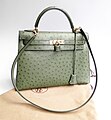奢华
外观
此条目可能包含原创研究。 (2016年5月16日) |


奢华指非必要但可为人类带来愉悦享受、昂贵不易得、或奢侈的事物或环境。大多欧洲语言中,奢华一词(如英文 luxury)都源于拉丁语 luxuria,指“过剩”或“生活中额外之物”,是“衣食足”以外的消费行为。[1]
奢华的世界史
[编辑]



在欧洲启蒙历史前后的脉络下,奢华一直是巴洛克式与洛可可式的国家重要组成部分,嵌镶于当时社会的政经逻辑中,也就是以君主宫廷的喜好花费为中心的社会来产出相关的经济活动。然而在18世纪,奢华受不同的政经逻辑影响,当奢华随著财富的中心渐从宫廷移往城市时,其活动同时刺激并表达了消费活动的兴起,进行将消费者和物件商品的新关系扩散于各地[2]。
世界史学家及中国研究学者卜正民将美洲大陆的发现和北美的探索和欧洲奢华消费的海狸毛皮连结起来,由于欧洲海狸近乎绝迹,而欧洲人枪炮的技术发展,让欧洲奢华消费能在北美找到新原料[3]。
奢华的政经理论
[编辑]苏格兰启蒙运动思想家对于奢华和经济活动的关系存有不同看法,伯纳德·曼德维尔将奢华合理化成有效的经济需求,而大卫·休谟则区分坏的奢华和无辜的奢华,支持后者对国家产业繁荣有帮助。詹姆斯·斯图亚特主张在对外贸易和内地贸易的初期阶段鼓励公民之间的奢华,但要将那些会降低人民活力及生产力的奢华排除在外[4]。
奢华的社经理论
[编辑]美国经济学家和社会学家托斯丹·范伯伦的炫耀性消费理论,认为奢侈品及其商虽无功能性但标示消费者的社会地位,也就是消费者透过物质财富的占有,来展示其高人一等的社会地位[5]。
参考书目
[编辑]- ^ 原来 (美术). 風格四論:生活美學與形象競爭力 生活美學與形象競爭力. 新锐文创. 1 October 2012: 4. ISBN 978-986-5915-12-4 (中文(台湾)).
奢华(luxury),在《新世纪经典美语大辞典》第四版的定义为:1.非必要但能带来愉悦及舒适的事物;2.昂贵或不易获得的事物;3.奢侈的生活或周遭环境。在拉丁语luxuria的原意是“过剩”或“生活中额外之物”,这不是人类的基本的生理需求,这是“衣食足”之后的消费行为。
- ^ Michel Delon. Luxury. Encyclopedia of the Enlightenment. Routledge: 783–786. 4 December 2013. ISBN 978-1-135-95998-2 (英语).
Luxury has been part and parcel of the baroque state, being embedded in the logic of societies centered on monarchical courts that generated economies based on eccentric spending. In the 18th century, however, luxury was subject to a different logic, as it developed alongside the slow shift in centers of wealth from the courts toward the cities, and simultaneously stimulated and expressed a rise in consumption and the spread of a new relationship of consumers to objects.
- ^ 卜正民. 維梅爾的帽子 從一幅畫看十七世紀全球貿易. 远流出版事业股份有限公司. 2009. ISBN 978-957-32-6452-1.
- ^ Tatsuya Sakamoto; Hideo Tanaka. The Rise of Political Economy in the Scottish Enlightenment. Routledge. 27 June 2005: 154. ISBN 978-1-134-43551-7 (英语).
On luxury we can see two strands of opinion among thinkers of the Scottish Enlightenment. One view was that luxury could contribute to economic development, which means luxury as effective demand. For example, Mandeville justified it in this way; Hume distinguished bad luxury from innocent luxury and supported the latter for the prosperity of national industries; and Steuart encouraged luxury among citizens in the nascent stages of foreign trade and inland trade, though excluding luxury which decreases the vitality of people and their productive power. Here the innocent luxury, different from the bad effects of luxury such as indolence, sensuality, corruption, prostitution and perdition, was accepted favourably, since it was a representative phenomenon of a polished and civilized society, and also an indication of the quantity of effective demand.
- ^ Barton Carl Beebe; Madhavi Sunder. The Luxury Economy and Intellectual Property Critical Reflections. Oxford University Press, Incorporated. 1 September 2015: 33. ISBN 978-0-19-933570-1 (英语).
Called the "Velben effect" after the American economist and sociologist Thorstein Veblen, this nonfunctional and status-signalling effect of luxury trademarks has been generally explained by recalling people's desire to signal wealth and social status "by conspicuous consumption," that is, by showing the possession of material wealth through products indicating superior social standing, such as the luxury products identified by these marks.












